Classical Conferences and Meetings 2013 |
NB: As best as possible, we also note presentations by B-C authors.
CANE – Classical Association of New England Annual Meeting
March 15–16, 2013
University of Connecticut
Storrs, CT
Representative: Donald Sprague
Presentation: "AcademicPub Creating Your Own Textbooks" – Donald Sprague
CAMWS – Classical Association of the Middle West and South
April 17–20, 2013
Sheraton Iowa City Hotel
Iowa City, IA
Representatives: Allan Bolchazy, Bridget (Buchholz) Dean, Donald Sprague
Presentations:
"Creating Custom Textbooks" – Bridget (Buchholz) Dean
“Land without War: The Vergilian Adunaton” – Lorina Quartarone, contributor LNM 2
“Pygmalion of the Printed Page: RUBY SPARKS” – Marianthe Colakis, coauthor Classical Mythology and More and Excelability in Advanced Latin
“A Voice in Turmoil - Musical Settings of Catullus’s Odi et Amo: Opportunities Grasped and Missed” – Philip V. Barnes, chorus director for CD Rome’s Golden Poets
“The ‘old philogical instinct’: Commenting on Ovid’s Remedia amoris” – Barbara Weiden Boyd, author Vergil’s AENEID: Expanded Collection, Vergil’s AENEID: Selected Readings from Books 1, 2, 4, and 6; coauthor A Vergil Workbook, Second Edition
“Politicizing the Silvae: The Reclamation of a Genre” – Carole Newlands, author “An Ovid Reader: Selections from Six Works (forthcoming)
“Vernae in the (Ecce) Roman Family” – Judith L. Sebesta, author Carmina Burana: Cantiones Profanae, coauthor Cicero: A LEGAMUS Transitional Reader
“’I’ll Take Blood Sucking Moths for Fifty’: Trusting the Ancients on Animal Lore” – Kenneth F. Kitchell, coauthor Catullus: A LEGAMUS Transitional Reader
“Tirones: A Collaborative Effort to Support New Teachers” – Mary Pendergraft, LNM consultant
“Teaching Beginning Greek on Digital Platforms” – Wilfred Major, coauthor Plato: A Transitional Reader
ACL - American Classical League
66th Annual ACL Institute
June 27–29, 2013
University of Memphis
Memphis, Tennessee
Representatives: Marie and Allan Bolchazy, Laurel Draper, Donald Sprague
Information taken from www.BOLCHAZY.com |
|
 |
|
One of the towns on Long Island badly damaged by Sandy was Long Beach. The town seal celebrates its coastal location as CIVITAS AD MARE.
The January/February 2013 edition of Archaeology includes an article of interest to those teaching Caesar—“Caesar’s Gallic Outpost: Hermeskell, Germany.” Archaeologists have found evidence of a temporary Roman military camp contemporaneous with Caesar’s Gallic campaigns as detailed in De bello Gallico.
Check out the current, February 2013, issue of National Geographic. The feature story “New Old Libya” details the rich bounty of classical remains in Libya and explains why the Qaddafi regime underplayed their significance. As one would expect, stunning photography accompanies the story.
The February 2013 Smithsonian article entitled “Classical Gas” provides the results of ice core data showing that the Romans emitted sufficient methane gas to impact the atmosphere.
The new Versace shop in New York City features a magnificent Roman-inspired mosaic floor in tribute to the company’s late founder, Gianni Versace. The header in the current issue of IN New York introducing the store is the playful “Veni, Vici, Versace.” |
|
 |
|
What better time than February to sample Jan Novak’s evocative interpretation of Dido’s tragic love?
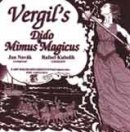
Vergil's Dido and
Mimus Magicus
Jan Novak
Pages: 40 pp/ libretto
Publication Date: 1997
Limited Edition CD
ISBN 978-0-86516-346-1
$15.00
For your listening pleasure . . .

Dido Summons the Departing Aeneas, Part 1 1:03 minutes

The Chorus Reflects on the
Force of Love 1:56 minutes |
|
|
Important Classics Deadlines |
Mar. 1, 2013: deadline to register for Exploratory Latin Exam to be administered between October 1, 2012 and April 1, 2013. |
|
|
Bolchazy-Carducci
Links of Interest |
Preview Bolchazy-Carducci Titles

Preview Bolchazy-Carducci titles before you buy using Google Preview.

Downloadable Products
iPodius - Bolchazy-Carducci Publishers online shop for: audio, software, video, and a treasure trove of teacher-created materials in the Agora.

BCP Facebook Fan Page
Become a FAN of Bolchazy-Carducci Publishers, visit our Facebook Fan page for the latest news from BCP.
*AP is a registered trademark of the College Entrance Examination Board, which was not involved in the production of, and does not endorse this product. |
|
|
Bolchazy-Carducci textbooks are now available through GooglePlay and DirectDigital (Xplana) eBookstores, with more titles going digital every day! Each eBook offers a variety of tools to enhance the learning process, and eBook distributors are continually adding new features.
What do B-C eBooks currently offer?
eBooks have the same content as our traditional books in print, with these enhancements:

• Searchable
• Adjust text size, typeface, line space
• Free samples of books
• Worry-free archive
• Available on any computer with an internet connection
• Readable on:
- the web (via Windows or MAC computers)
- iPhone, iPad and iPod touch
- Android
- eBook Devices: Barnes & Noble Nook and Reader™ from Sony
GooglePlay ebook information
GooglePlay ebook store: http://books.google.com/ebooks

(Formerly Xplana)
• Searchable
• Adjust text size, typeface, line space
•Add notes, customized highlights, and other annotations—all of which are added to the embedded annotation manager for convenient access
• Worry-free archive
• Available on any computer with an internet connection
• Readable on:
- the web (via Windows or MAC computers)
- tablet computers
DirectDigital ebook information
DirectDigital ebook store
How do I purchase a B-C eBook?
Simple! When you are browsing through www.Bolchazy.com, any time you see GooglePlay or DirectDigital eBook logo, click on the logo, and you will automatically be directed to a webpage where you can purchase the eBook.
Can I purchase direct from the distributor?
Yes! If you prefer, you can link directly to our eBook providers’ websites and search by title, by author, or by Bolchazy-Carducci Publishers to locate the title you would like to purchase. The GooglePlay ebooks store offers a preview of the book, including the table of contents and select pages.
What hardware is required?
You can read eBooks on a Mac, PC, iPhone, iPad, Android, or a variety of eReaders. |
|
 |
|
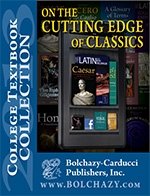
College professors should have received a copy of the 2013 College Catalog in January. If you did not receive a copy or have misplaced yours, contact us at info@bolchazy.com to request one. Please provide your USPS address as well as your email address.
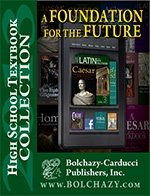
High school and middle school teachers should be receiving their copies of the 2013 High School Catalog the week of February 18th. If you do not receive your copy, contact us at info@bolchazy.com to request one. Please provide your USPS address as well as your email address. If you provide your home address, please give us your school affiliation as well. |
|
|
Graceland has set up two new travel-themed exhibits at Elvis Presley’s Memphis, Tennessee home. One exhibit features artifacts to Elvis’s Hawaii concerts and movies while the other focuses on Las Vegas and includes such items as the King’s first onstage jumpsuit from 1970.
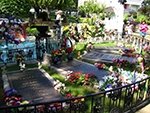
Graceland Cemetary at Graceland Mansion, Memphis, Tennessee. Photo Courtesy of Wikimedia Commons. |
|
|
|
|
Just as we were putting a wrap on this issue of eLitterae, Pope Benedict XVI stunned the world with his announcement that he would retire at the end of the month. My editor-colleague Laurie Keenan emailed me a terrific link that demonstrates the value of knowing Latin. The journalist who got the scoop on the resignation did so because she knew Latin! Check it out:
http://www.thenewstribe.com/2013/02/12/popes-resignation-latin-helps-journalist-giovanna-chirri-get-the-scoop/
I would love for you to send along items to share in the monthly “Classical Tidbits” column. Please send them to don@bolchazy.com.
Donald Sprague
Editor |
|
|
A Latin teacher wears many hats . . .
When most of us started our teaching careers, we didn’t know that we would spend a part of our time being a public relations specialist. However since we are in a field where students have choices, that’s our reality. Your English teacher colleagues don’t have to recruit for their core subject. I have had many conversations with math or social studies teachers who didn’t understand the peril of being a teacher of an academic elective. We have to walk that fine line between holding students to standards and making sure that there are enough ways for them to succeed, because another class awaits them down the hall.
I am dedicating this column to that part of our jobs that no one taught us in education classes—creating that ‘buzz’ that encourages kids to enroll in your classes. I won’t deal with the many obstacles we all encounter—the not-so-helpful counselor, the passive-aggressive modern language teacher, the colleague who had a bad Latin experience and is not afraid to share it. I want to focus on what we can do, in spite of the obstacles.
I believe strongly that students are drawn to classes where they learn something. I didn’t say ALL kids, and I certainly didn’t say that all kids learn the same way. If your outcome goals are realistic for your students and your students feel you genuinely care about their success, it goes a long way. I once had a parent who told me that even though her son was getting a D in Latin, she said it was the happiest D he had ever received, because he felt I was on his side. That interaction reminded me that I had a student who wanted and needed some support and help, and we got his grade up.
This is the time of year when students make selections for their courses for next year. I find it hard to recommend any one thing that is a “can’t miss” idea here because schools have different philosophies about how to promote languages. Some schools have something like a curriculum fair, where the students and parents come around and talk to teachers. Other schools have language teachers visit students in the lower grades and promote their offerings. Many schools rely on word-of-mouth or have counselors take the lead.
Each approach has its pros and cons, and often the reason for choosing an approach is not a matter for discussion, it’s “the way we have always done it.” I believe that promotion happens all year long, and the focus that happens before course selection may have some impact, but not as much as what happens during the year.
If you are looking for materials to use for a promotional display or presentation, check out the following.
- www.promotelatin.org lives up to its name as a location for promotional materials. This website is run by the National Committee for Latin and Greek (NCLG), an umbrella organization for local, state and national Classical associations. NCLG does lobbying and advocacy for Classical languages study. Explore the website and discover the free, downloadable materials available.
- The ACL Teaching Materials and Resource Center (TMRC) offers promotional items under the “MISC” tab, but also look at the POSTERS and TEACHING PACKETS sections.
- The Bolchazy-Carducci website has several places to look for resources. Under the LATIN ADVANTAGE tab are some statistics and fun facts you can use in your promotional materials. Under the LATIN tab is a link to the ever-popular buttons which you can give as prizes or as something to hand out.
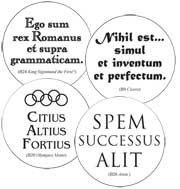
Involving your current students as best you can is a great idea. Your students are your best salespeople! All seventh and eighth graders, no matter what they say, think high school students are cool. They value those high schoolers’ advice. If you have a Latin Club or a JCL chapter, get them involved in generating promotional ideas. If you make a presentation, show pictures of students actively engaged in Latin activities. Always check your school’s privacy policy, but most of the time it is fine if the pictures are internal to the school and not published in any way. But always check!
Kids want to see a class that is lively. In last month’s column I described a communicative activity for Valentine’s Day. Make sure some of those Valentines go on your door or in the hallway (as school policy permits). Make sure that Latin is a part of your whole school community. Plan a service project and be sure to publicize it when you are done. Have Latin students volunteer to tutor middle school or elementary school kids after school, in any subject, but give the younger kids a Latin promotional gift like a button or a bookmark. Find out who teaches ancient topics like Mythology or Ancient History. Send them copies of the catalogues you purchase from with some of your favorite items starred. If your schedule is flexible, volunteer to go talk to one of the classes about your trip to Italy, or tell your favorite myth, or read to them from an easy reader such as I Am Reading Latin Series Set or I am Reading Latin Stories set of four books. The younger students will like hearing something read in Latin—and they always understand it, which makes them feel very smart. Make sure anyone who teaches mythology is aware of the mythology exams from www.etclassics.org and Medusa Exam. I recommend looking through the National Junior Classical League webpage. Look at the sections labeled ACTIVITIES, RESOURCES, and COMMUNITY SERVICE for some great ideas.
As you get wrapped up in planning, teaching, grading, and actually having your own life, the temptation is to let things like this go. Just remember however that no one will do this for you. If you believe that you have something of value to offer the students in your school community, then you need to make sure everyone knows about it. If you are a pro at promotion, share your ideas with me at slittle6@cinci.rr.com and I will put them in a future column. If you are just getting started, try one or two of these suggestions. Then next year modify what didn’t work, then add something new. If you develop these as habits, then it won’t seem like one more thing to add on to your already sizeable load, it is simply something you already do. The rewards are worth the effort.
Sherwin Little
Editor’s Note: Frustrated with the territorialism of world language teachers? Here’s a tip I learned from attending the Wisconsin Latin Teachers Association meeting as part of the 2011 Wisconsin Association of Foreign Language Teachers. Consider following the example of Brookfield High School in Wisconsin. Rather than compete with one another and pit one language against another, the language teachers decided to collaborate and collectively promote all the languages. So, they encouraged their Level 2 students to continue on to Level 3 in the language they had started and to begin another language as well. The results? All languages experienced enrollment increases! |
|
 |
|
AIA-APA 2013 Conference Report |
Seattle and the Washington State Convention Center welcomed some 2,200 classicists for the Annual Meeting of the AIA-APA. The weather gods favored the gathering with sunny days (a feat for the rainy Seattle) and with rain limited to the evenings. Allan and Marie Bolchazy along with editors Bridget Dean and Donald Sprague staffed a double booth in the exhibit hall. A small table at the front of the booth honored Lou Bolchazy with a display of his favorite books, his medal from the Slovak government recognizing his contributions to Slovak culture, and a computer showing tributes to Lou. All of us were very touched by those who stopped by to share their own stories of and tributes to Lou.
We always look forward to the APA as an opportunity to touch base with some of our authors and this year chatted with Ronnie Ancona, Madeleine Henry, Tim Winters, Paul Allen Miller, Victoria Pagán, Larissa Bonfante, Judy Hallett, and Barbara Weiden Boyd among others. These chats keep us up to date with the authors and provide us ideas how to spread the word about their titles or what new titles to consider. At Saturday’s reception, editor Don Sprague was able to confer with Mary Pendergraft and Hans-Friedrich Mueller about their upcoming webinars.
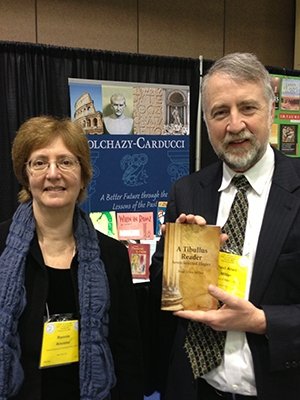
BC Latin Readers series editor Ronnie Ancona and author Paul Allen Miller pose at the B-C exhibit. Miller’s book A Tibullus Reader: Seven Selected Elegies arrived from the printer just in time for APA.
While a western location traditionally results in lower attendance, a steady stream of visitors to the B-C exhibit showed strong interest in our titles. We were pleased to see professors check on and inquire about the latest titles published in the BC Latin Readers. The conference also gave beginning Latin instructors an opportunity to check out Latin for the New Millennium and the latest addition to the series, the College Exercise Book by Milena Minkova. Fortune smiled on the series when we were able to connect someone contemplating an LNM adoption with someone else at the exhibit who was currently using it.
The editors enjoyed the opportunity to connect with former colleagues, professors, and students as well as the opportunity to attend some of the presentations. Bridget Dean checked out a session on religion and ritual, one of her research interests, while Don Sprague took in the Caesar panel.
From multiple perspectives, the 2013 APA-AIA meeting was a grand success for B-C. |
|
 |
|
New York Classical Club Workshop |
Neither temperatures in the teens nor a blanket of snow deterred classicists from attending the January 26 daylong workshop devoted to Caesar hosted by New York University. Approximately 90 attendees—high school teachers, graduate students, college professors, independent scholars, and AP students from the city as well as from Connecticut, Massachusetts, and New Jersey filled Jury Hall to capacity.
Club president, Matthew McGowan of Fordham University, lined up a roster of Caesar all-stars for the workshop: Cynthia Damon from UPenn, Luca Grillo from Amherst College, Hans-Friedrich Mueller from Union College, Kurt Raaflaub from Brown University, and James Hunt from Fayetteville-Manlius High School, Syracuse, NY who spoke from his experience implementing Caesar and the new AP curriculum.
Each presenter spoke for forty-five minutes while many attendees filled lined notepads, ipads, or laptops with notes. Following each presentation, audience members took full advantage of every minute allotted to pepper the speakers with probing questions and to raise their own well-found insights.
NYU host, Professor David Sider, helped by his graduate student assistant George Baroud, worked sedulously to ensure everyone felt welcome. They made sure the crowd was well fed—coffee, bagels, and pastries before the sessions, sushi and salads for lunch, afternoon coffee with fruit, cookies, and other pastries, and a wine reception with cheeses.
Those attending left satisfied that they had learned more about Caesar, had been well hosted, and had connected with old classicist friends and had made some new friends as well.
Photo Gallery

A snow covered Washington Square with its triumphal arch. The square is surrounded by the campus of NYU.
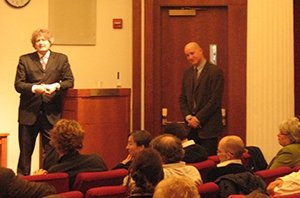
Hans-Friedrich Mueller, Union College, addresses questions following his talk “Caesar and the State Religion.” Standing to his right is NYCC President Matthew McGowan.

Afternoon treats kept the audience perked up and eager for the next presentation.
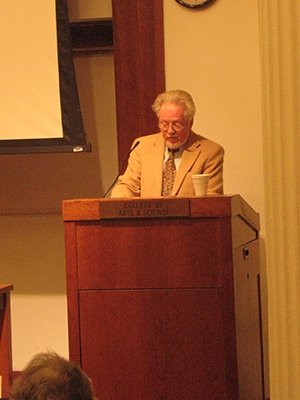
Kurt Raaflaub, Brown University, delivers his presentation “Caesar the General and Statesman: A Literary Self-Portrait of the Perfect Roman.” |
|
 |
|
Enrichment Resource
Have you ever seen Saudi Aramco World? It’s a fascinating, richly illustrated magazine about the Arab world and culture. The November/December 2012 issue includes such articles as “Little Syria, NY” about the ethnic enclave established in 1870s Manhattan; “The Happy Ones” about the hamadryas baboon native to Arabia; “Free Running Gaza” that tells the story of a special youth program; and “New Flavors for the Oldest Recipes” that includes several recipes from ancient Mesopotamia. The magazine explores the nexus between Arab culture and other cultures—regularly making connections to the classical world. Each issue includes a classroom guide and an international listing of events and exhibitions related to the Arab world. It’s consistently an enjoyable and informative read. And, it’s free! Check out saudiaramcoworld.com. You can also register for access to the sites photograph archives.
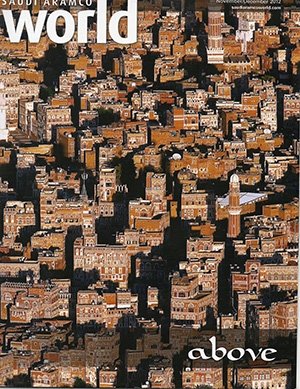
November/December 2012 Saudi Aramco World |
|
|
Latin for the New Millennium
Teaching Tips |
LNM 2
File this tip away for use next year as an enrichment activity when you do Review 2 of LNM 2, for use during the year as a review or enrichment activity, or as a complement to From Rome to Reformation. The saudiaramcoworld.com website includes a virtual tour of the magnificent Islamic palace, the Alhambra in Granada, Spain. Classes comfortable discussing Roman architecture might note the differences and similarities between Roman and Arab architecture as part of this learning activity.
Valentine’s Day
Valentine’s Day provides a terrific opportunity for students to review the love affairs they have encountered in their LNM Latin readings. The class can do this as a brainstorming exercise having the teacher fill the board with love stories they remember from their reading. The class can then be broken into small groups with each group reviewing a specific love story in preparation for presentation to the class. Each group would report on the nature of the relationship and how it evolved. They could cite the language of love used in each reading. As a synthesis activity, the class would then discuss how the love affairs were similar or dissimilar.
LNM 1
Chapter 5 Cicero’s Love Letter to his Wife Terentia
Chapter 7 Catullus’s Passer Poem (Carmen 2)
Chapter 11 Vergil’s Aeneas and Dido Love Affair
Chapter 14 Ovid’s Pyramus and Thisbe
Chapter 18 Apuleius’s Cupid and Psyche
LNM 2
In addition to recalling the love stories from LNM 1, students may also discuss the following from their Level 2 reading.
Chapter 3 Heloise’s Letter to Abelard
Review 1 “Exploring Tragic Love Stories Through the Ages: Love and Longing” by Lorina Quartarone, The University of St. Thomas, Minneapolis, Minnesota
Chapter 6 Dē Pīrātae Fīliā
Teachers may wish to provide the background to Valentine’s Day and present such information as the Christian saint who is commemorated on February 14, the belief that the early church established that date to co-opt the Roman feast of the Lupercalia that took place on the 15th, and the custom of sending Valentine greetings, among others. A handy site for such information is http://www.history.com/topics/valentines-day.
The oldest known valentine still in existence is a poem written in 1415 by Charles, Duke of Orleans, to his wife while he was imprisoned in the Tower of London following his capture at the Battle of Agincourt. The greeting is part of a manuscript in the British Museum. An image from this manuscript serves as the chapter image for the Heloise and Abelard chapter in LNM 2 and a full view of that manuscript page is presented on p. 63. |
|
 |
|
Special Title Discounted for eLitterae Subscribers |
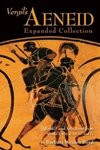
Vergil's Aeneid Expanded Edition
By Barbara Weiden Boyd
This well-annotated Latin text combines new content and four Aeneid texts previously published by Bolchazy-Carducci into one user-friendly volume. Containing 2,596 lines, this text contains all of Book 1 and significant passages from Books 2, 4, 6, 8, 10, 11, and 12 so students can meet the likes of Camilla, Turnus, and Evander as well as Pyrrhus, Dido, and the Sibyl. Check it out, this is the perfect text for teachers who want to do the required AP lines as well as other Aeneid passages.
xl +449 pp (2013) Paperback ISBN 978-0-86516-789-6
$29.00 $20.00 PLUS free media rate shipping in the USA
(no returns, not available to distributors.
This offer expires 2/28/13)
Make sure to mention that you are an eLitterae subscriber if you place your order by phone or fax. If you place your order via www.BOLCHAZY.com, the special eLitterae offer pricing will be charged at checkout. |
|
|
|
|
